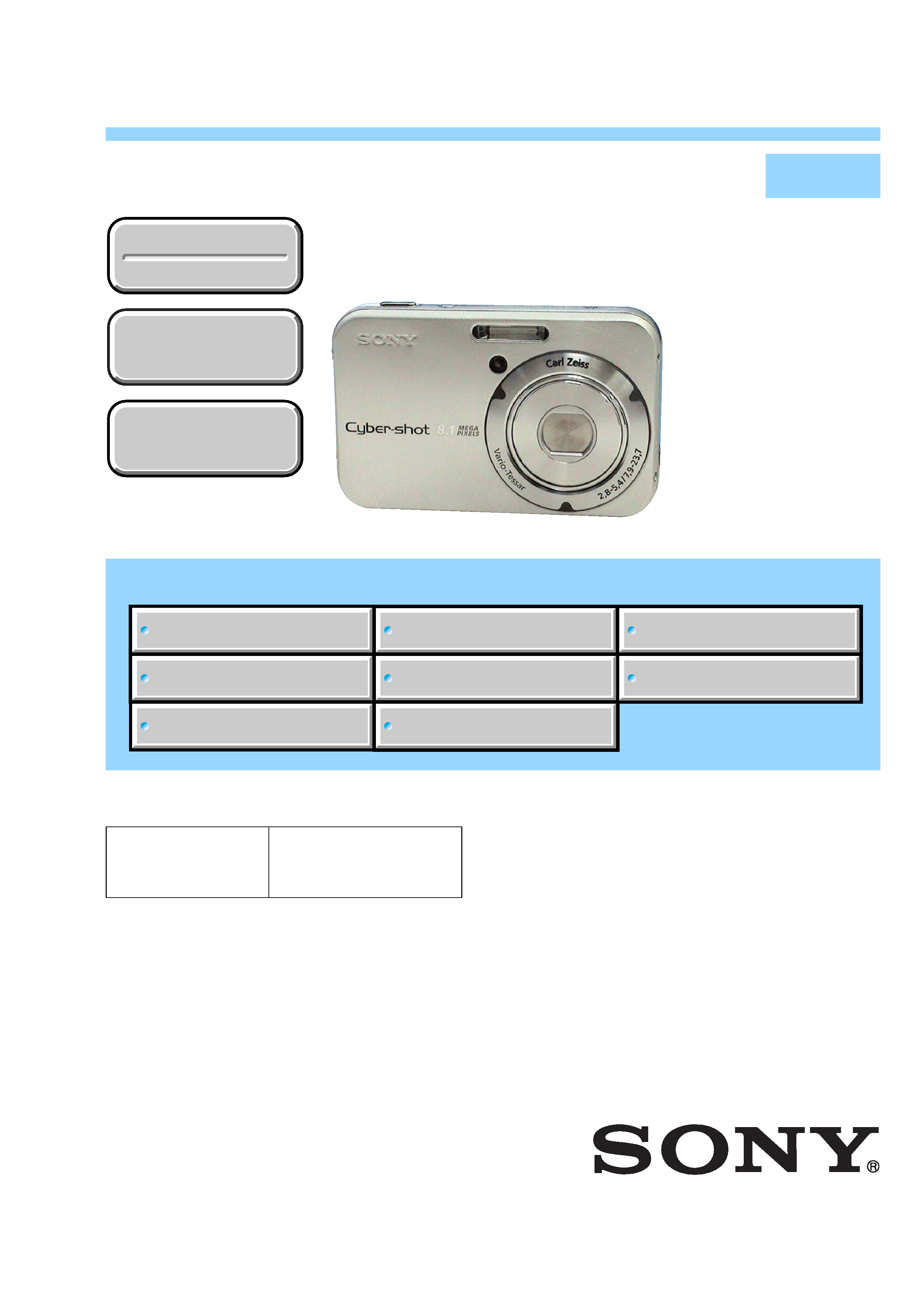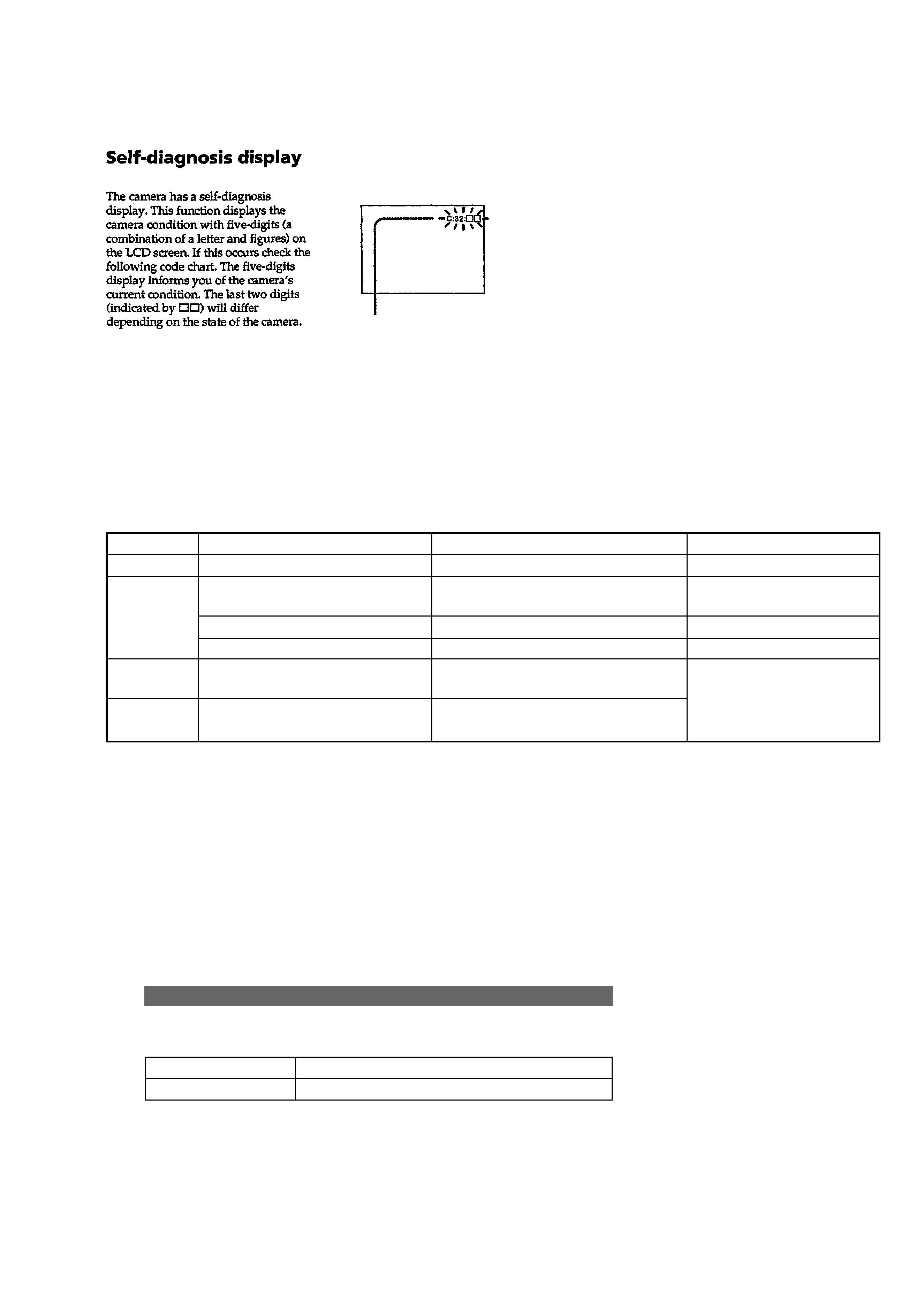
SERVICE MANUAL
LEVEL
2
Link
DISASSEMBLY
SERVICE NOTE
SPECIFICATIONS
SCHEMATIC DIAGRAMS
FRAME SCHEMATIC DIAGRAMS
BLOCK DIAGRAMS
REPAIR PARTS LIST
PRINTED WIRING BOARDS
Link
Revision History
Revision History
How to use
Acrobat Reader
How to use
Acrobat Reader
Sony EMCS Co.
DSC-N1_L2
Internal memory
ON BOARD
Internal memory
ON BOARD
Ver 1.2 2005.12
DIGITAL STILL CAMERA
2005L0500-1
© 2005.12
Published by DI Technical Support Department
9-876-908-32
US Model
Canadian Model
AEP Model
UK Model
E Model
Australian Model
Hong Kong Model
Chinese Model
Korea Model
Japanese Model
Tourist Model
The components identified by
mark 0 or dotted line with
mark 0 are critical for safety.
Replace only with part num-
ber specified.
Les composants identifiés par une
marque 0 sont critiques pour la
sécurité.
Ne les remplacer que par une pièce
portant le numéro spécifié.
· Precaution on Replacing the SY-138 Board
DSC-N1

-- 2 --
DSC-N1_L2
SPECIFICATIONS
Camera
[System]
Image device
9.10 mm (1/1.8 type) color
CCD, Primary color filter
Total pixel number of camera
Approx. 8 303 000 pixels
Effective pixel number of camera
Approx. 8 068 000 pixels
Lens
Carl Zeiss Vario-Tessar
3
× zoom lens
f = 7.9
- 23.7 mm (38 -
114mm when converted to a
35 mm still camera)
F2.8
- 5.4
Exposure control Automatic exposure, Manual
exposure, Scene Selection (8
modes)
White balance
Automatic, Daylight, Cloudy,
Fluorescent, Incandescent,
Flash
File format (DCF compliant)
Still images: Exif Ver. 2.2
JPEG compliant, DPOF
compatible
Movies: MPEG1 compliant
(Monaural)
Recording media Internal Memory (26 MB)
"Memory Stick Duo"
Flash
Recommended distance (ISO
set to Auto): approx. 0.20 m to
5.0m (7 7/8 inches to 8 feet
63/8 inches) (W)/approx.
0.34 m to 2.6 m (1 feet 1 1/2
inches to 16 feet 4 7/8 inches)
(T)
[Input and Output connectors]
Multi connector
USB communication
Hi-Speed USB (USB 2.0
compliant)
[LCD screen]
LCD panel
7.5 cm (3 type) TFT drive
Total number of dots
230 400 (960
×240) dots
[Power, general]
Power
Rechargeable battery pack NP-
BG1, 3.6 V
AC-LS5K AC Adaptor (not
supplied), 4.2 V
Power consumption (during shooting)
1.3 W
Operating temperature
0
°C to +40°C (+32°F to
+104
°F)
Storage temperature
-20°C to +60°C (-4°F to
+140
°F)
Dimensions
96.7
× 61.1 × 22.7 mm
(3 7/8
× 2 1/2 × 29/32 inches)
(W/H/D, excluding protrusions)
Mass
Approx. 185 g (6.5 oz)
(including NP-BG1 battery
pack, wrist strap, stylus, etc.)
Microphone
Electret condenser microphone
Speaker
Dynamic speaker
Exif Print
Compatible
PRINT Image Matching III
Compatible
PictBridge
Compatible
BC-CSG battery charger
Power requirements
AC 100 to 240 V, 50/60 Hz,
2 W
Output voltage
DC 4.2 V, 0.25 A
Operating temperature
0
°C to +40°C (+32°F to
+104
°F)
Storage temperature
-20°C to +60°C (-4°F to
+140
°F)
Dimensions
Approx. 62
× 24 × 91 mm
(2 1/2
× 31/32 × 3 5/8 inches)
(W/H/D)
Mass
Approx. 75 g (2.7 oz)
Rechargeable battery pack NP-BG1
Used battery
Lithium-ion battery
Maximum voltage
DC 4.2 V
Nominal voltage DC 3.6 V
Capacity
3.6 Wh (960 mAh)
Design and specifications are subject to change
without notice.

-- 3 --
DSC-N1_L2
SAFETY-RELATED COMPONENT WARNING!!
COMPONENTS IDENTIFIED BY MARK 0 OR DOTTED LINE WITH
MARK 0 ON THE SCHEMATIC DIAGRAMS AND IN THE PARTS
LIST ARE CRITICAL TO SAFE OPERATION. REPLACE THESE
COMPONENTS WITH SONY PARTS WHOSE PART NUMBERS
APPEAR AS SHOWN IN THIS MANUAL OR IN SUPPLEMENTS
PUBLISHED BY SONY.
ATTENTION AU COMPOSANT AYANT RAPPORT
À LA SÉCURITÉ!
LES COMPOSANTS IDENTIFÉS PAR UNE MARQUE 0 SUR LES
DIAGRAMMES SCHÉMATIQUES ET LA LISTE DES PIÈCES SONT
CRITIQUES POUR LA SÉCURITÉ DE FONCTIONNEMENT. NE
REMPLACER CES COMPOSANTS QUE PAR DES PIÈSES SONY
DONT LES NUMÉROS SONT DONNÉS DANS CE MANUEL OU
DANS LES SUPPÉMENTS PUBLIÉS PAR SONY.
1.
Check the area of your repair for unsoldered or poorly-soldered
connections. Check the entire board surface for solder splashes
and bridges.
2.
Check the interboard wiring to ensure that no wires are
"pinched" or contact high-wattage resistors.
3.
Look for unauthorized replacement parts, particularly
transistors, that were installed during a previous repair. Point
them out to the customer and recommend their replacement.
4.
Look for parts which, through functioning, show obvious signs
of deterioration. Point them out to the customer and
recommend their replacement.
5.
Check the B+ voltage to see it is at the values specified.
6.
FLEXIBLE Circuit Board Repairing
· Keep the temperature of the soldering iron around 270°C
during repairing.
· Do not touch the soldering iron on the same conductor of the
circuit board (within 3 times).
· Be careful not to apply force on the conductor when soldering
or unsoldering.
Unleaded solder
Boards requiring use of unleaded solder are printed with the lead-
free mark (LF) indicating the solder contains no lead.
(Caution: Some printed circuit boards may not come printed with
the lead free mark due to their particular size.)
: LEAD FREE MARK
Unleaded solder has the following characteristics.
· Unleaded solder melts at a temperature about 40°C higher than
ordinary solder.
Ordinary soldering irons can be used but the iron tip has to be
applied to the solder joint for a slightly longer time.
Soldering irons using a temperature regulator should be set to
about 350
°C.
Caution: The printed pattern (copper foil) may peel away if the
heated tip is applied for too long, so be careful!
· Strong viscosity
Unleaded solder is more viscous (sticky, less prone to flow) than
ordinary solder so use caution not to let solder bridges occur such
as on IC pins, etc.
· Usable with ordinary solder
It is best to use only unleaded solder but unleaded solder may
also be added to ordinary solder.
SAFETY CHECK-OUT
After correcting the original service problem, perform the following
safety checks before releasing the set to the customer.
CAUTION
Danger of explosion if battery is incorrectly replaced.
Replace only with the same or equivalent type.

-- 4 --
DSC-N1_L2
TABLE OF CONTENTS
1.
SERVICE NOTE
1-1.
Description on Self-diagnosis Display ···························· 1-1
1-2.
Process After Fixing Flash Error ····································· 1-1
1-3.
Method for Copying or Erasing the Data in Internal
Memory ··········································································· 1-2
1-4.
Precaution on Replacing the SY-138 Board ···················· 1-3
2.
DISASSEMBLY
2-1.
Disassembly ····································································· 2-3
2-2.
The Method of Attachment of Cabinet Center Block ······ 2-5
2-3.
Exchange Method of Barrier Assembly ·························· 2-7
2-4.
Exchange Method of LSV-1100A ································· 2-10
3.
BLOCK DIAGRAMS
3-1.
Overall Block Diagram (1/2) ··········································· 3-1
3-2.
Overall Block Diagram (2/2) ··········································· 3-3
3-3.
Power Block Diagram ····················································· 3-5
4.
PRINTED WIRING BOARDS AND
SCHEMATIC DIAGRAMS
4-1.
Frame Schematic Diagram ·············································· 4-1
4-2.
Schematic Diagrams ························································ 4-5
4-3.
Printed Wiring Boards ··················································· 4-31
5.
REPAIR PARTS LIST
5-1.
Exploded Views ······························································· 5-2
5-2.
Electrical Parts List ························································· 5-7
Section
Title
Page
Section
Title
Page

1-1
DSC-N1_L2
1. SERVICE NOTE
Self-diagnosis display
· C: ss: ss
You can reverse the camera
malfunction yourself. (However,
contact your Sony dealer or local
authorized Sony service facility
when you cannot recover from the
camera malfunction.)
· E: ss: ss
Contact your Sony dealer or local
authorized Sony service facility.
Display Code
C:32:ss
C:13:ss
Countermeasure
Turn the power off and on again.
Format the "Memory Stick" or internal
memory.
Cause
Trouble with hardware.
"Memory Stick" or internal memory is
unformatted.
Caution Display During Error
SYSTEM ERROR
FORMAT ERROR
MEMORY STICK ERROR
E:61:ss
E:91:ss
1-1. DESCRIPTION ON SELF-DIAGNOSIS DISPLAY
Insert a new "Memory Stick".
"Memory Stick" is broken.
Turn the power off and on again.
Trouble with internal memory.
INTERNAL MEMORY ERROR
Checking of lens drive circuit.
When failed in the focus and zoom
initialization.
--
Checking of flash unit or replacement
of flash unit. (Note)
Abnormality when flash is being
charged.
Note: After repair, be sure to perfom "1-2. PROCESS AFTER FIXING FLASH ERROR".
1-2. PROCESS AFTER FIXING FLASH ERROR
When "FLASH error" (Self-diagnosis Code E : 91 : ** ) occurs, to prevent any abnormal situation caused by high voltage, setting of the
flash is changed automatically to disabling charge and flash setting.
After fixing, this setting needs to be deactivated. Flash error code can be initialized by the operations on the Setup screen.
Method for Initializing the Flash Error Code
Initializes the setting to the default setting.
The message "Initialize all settings Ready?" appears.
· Make sure that the power is not disconnected during resetting.
Initialize
OK
Resets the settings to the default setting.
Cancel
Cancels the resetting.
